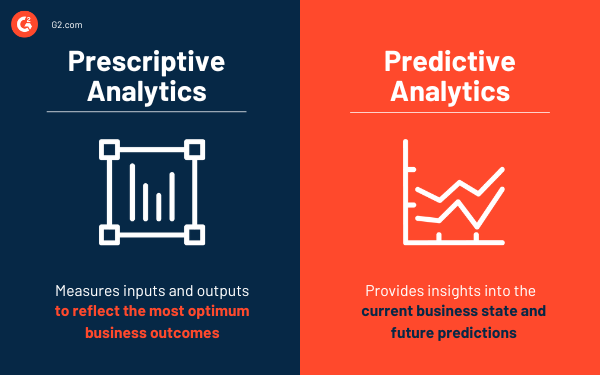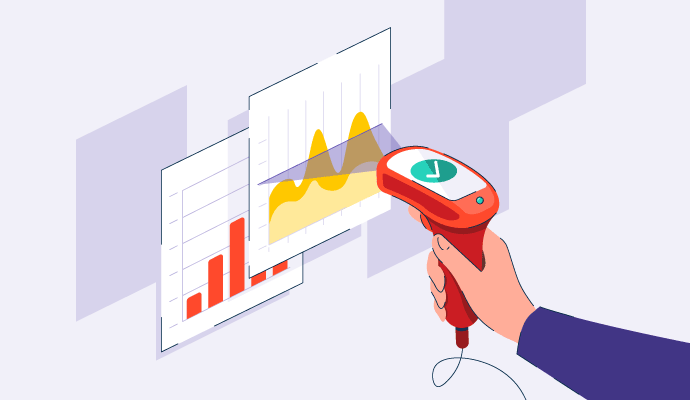A world where your business knows what's in store for it.
Prescriptive analytics is changing the way data transforms business operations and practices. The approach is widely used to conduct manual analyses, develop actionable plans to align with predicted outcomes, and integrate analytical tools with in-built algorithms.
Implementing prescriptive analytics improves decision-making and develops effective business strategies. Organizations use analytics platforms or business intelligence solutions for data organization, discovery, and analysis to convert information into a game plan.
What is prescriptive analytics?
Prescriptive analytics analyzes raw data to suggest a course of action beyond explanations and predictions. It drives data-based decision-making as it predicts what could happen in the future and recommends ways to refine business practices and expected outcomes.
To examine data, prescriptive analytics factors in information about past and current performance with the available resources to develop possible scenarios. Aspects of business such as supply chain, labor, and energy costs are also considered when building a prescriptive model.
How prescriptive analytics works
In the greater realm of a multi-step data analysis approach, prescriptive analytics is often the last stage for a business because it helps align relevant goals and perfect strategies.
The 3 main parts of data processing in business analytics
- Descriptive analytics describes a company’s current state using engagement metrics, customer feedback, sales numbers, and website traffic. It essentially describes present business circumstances based on past events by answering the question, “What happened?”
- Predictive analytics develops predictions for the future by applying mathematical models, outcomes from descriptive analysis, and machine learning (ML). This step helps answer “What might happen?”.
- Prescriptive analytics goes beyond making predictions and combines ML with artificial intelligence (AI) and algorithms to generate strategic approaches for multiple business outcomes. By tweaking certain variables, prescriptive analytics seeks to optimize organizational performance and future courses of action to answer “What should happen next?”
Prescriptive data analytics works in tandem with all three stages of data analytics and is integral to the overall business analytics process.
Prescriptive analytics uses artificial intelligence techniques to understand the available data and resources. A highly adaptable data approach, prescriptive analysis makes sense of new data as it’s available to adjust predicted outcomes accordingly. This makes it possible for organizations to make informed decisions in real time, which helps with strategic planning and business forecasting.
Want to learn more about Analytics Platforms? Explore Analytics Platforms products.
Prescriptive analytics examples
In today’s world, customers and users expect every organization, regardless of its industry, to be data-ready and data-responsive. People want quick access to their data and make decisions based on accurate facts. It’s no surprise that prescriptive analytical models see increased use across sectors.
Accurate data and trend forecasting in healthcare
Prescriptive analytics play a major role in providing accurate patient information for better-informed clinical processes. Hospitals and clinics implement data analytics to manage healthcare analytics processes better and get accurate insights for better clinical data and patient management.
As an integral part of healthcare data analytics, prescriptive analytics models provide insights that improve clinical care quality and data transparency concerning patient treatment options and pricing.
Prescriptive analytics and healthcare analytics software offers healthcare providers valuable input into healthcare trends and predictions, which can better support hospital frameworks and policies.
For example, data models that predicted a surge in COVID-19 cases in specific regions during the pandemic were used as inference points to focus medical efforts at those locations. This empowered healthcare workers to deal with patient overload.
Product lifecycle management
Data-based products are winning in the current business landscape. Many product managers depend on data models to conduct market research, test minimum viable products (MVPs), and collect demographic and behavioral data for end users.
Prescriptive analytical models identify buying trends to predict which product types and features are most relevant in the marketplace. In product lifecycle management (PLM), this knowledge is critical for refining a user’s experience with the product.
Lead scoring in sales
By implementing prescriptive analytics in sales, sales reps can quickly target customers ready to buy.
Taking advantage of lead scoring is one of the main ways companies use prescriptive analytics models to move customers down the sales funnel. Lead scoring works on creating point values for different leads by aligning sales and marketing teams. Every action a prospect takes during lead generation is assigned a certain score. The higher the points achieved, the more “sales-ready” that prospect is.
Prescriptive analysis scores leads based on data collected from actions like page views, email interactions, and website engagement. The algorithm ranks these leads based on their scores to provide information about the likelihood of their conversion. This is extremely valuable for perfecting customer journey maps and saving time and money that may have been spent in sourcing leads.
Email automation in marketing
Did you know that your email marketing campaigns are powered by prescriptive analytics?
A marketer’s best friend, email automation, employs prescriptive analytics to categorize leads based on their motivations and preferences to personalize content for different customer segments. Algorithms developed through data analytics help set up specific triggers for user groups which can automatically send out customized messages without manual effort.
Setting up pre-designed triggers and content benefits marketers who want to scale personalized campaigns and increase conversions through better targeting methods.
Benefits of prescriptive analytics
Prescriptive analytics is a data-driven approach to optimizing the efficiency of business operations and performance. By utilizing raw data, prescriptive analytics effectively scales an organization’s business intelligence and increases its reliance on high-quality big data and actionable insights.
- Develops a data-backed roadmap. Prescriptive analysis enables leaders to design product roadmaps that direct goal prioritization. The models developed generate simulated actions for different business cases to minimize future failure risk.
- Sustains continued growth. With real-time insights, stakeholders can access data forecasts to support sustained operational growth. Since prescriptive analyses focus on predictions and recommendations, decision-making becomes simpler and faster.
- Reduces errors and biases. We love to hate machines and their powerful capabilities (I’m looking at you, ChatGPT!). But whether we accept it or not, advanced algorithms and ML processes provide comprehensive data aggregation opportunities that benefit data management across departments.
Disadvantages of prescriptive analytics
Data analysis is imperfect and requires human intervention to help it become more foolproof with time and technological advancement.
Prescriptive analytics, in particular, is only effective if leaders are looking for the right answers from the datasets. Knowing what to assume and which factors to consider is crucial to developing analytical models, as the output depends on the assumptions' validity.
Different data analytics platforms also have different capabilities. Invest in a solution that provides real and concrete data results over big promises.
Since most of the predictions and recommendations provided through prescriptive analyses are made using the data available at that specific point in time, the outcomes aren’t suited for more long-term business decisions. Think of it like this – the more time passes, the higher the risk for data unreliability.
How to implement prescriptive analytics
Knowing where to start is a universal dilemma. That can be scary, combined with overwhelming data and navigating new models.
The secret to staying sane while getting the most out of the prescriptive analytical method is treating it like any new marketing campaign or collaborative project.
Set realistic and specific goals
I wasn’t kidding when I said treat it as you would any new business strategy. A good data analytical model is built out of objectives involving more than just tracking a few metrics. Data can be endless, and if left unorganized, chaotic.
Outline an analysis plan by identifying why your company department would benefit from prescriptive analytics. A few questions to consider during goal setting:
- What is the primary reason for implementing the data approach? (Competitors, better data quality, improved forecasting)
- What are some specific goals that can be achieved with the analytics?
- Which issues require reassessment? What should be the extent of implementation?
Develop a well-defined framework
Once you’ve identified which goals and issues to address and which processes to optimize, it’s time to reflect and create an actionable plan. You have to develop a researched framework to achieve effective prescriptive analytics.
- Assemble a dedicated team. Define the roles and responsibilities of the people making the transition.
- Research. Collaborate and ideate on ways to define problems and devise plans to solve them using the new data analysis methodology.
- Work in phases. Develop proof of concepts to see if you’re moving toward a suitable solution.
- Conduct reviews and tests. Design and implement the prescriptive analysis model and its features based on your business needs. Validate the model through feedback loops and hypotheses.
- Configure the model. Identify which data is required to address the technical elements of the prescriptive model.
- Roll out to stakeholders. Begin full prescriptive operations and evaluate initial findings once available.
Prescriptive analytics vs. predictive analytics
Prescriptive analytics is often confused or used interchangeably with predictive analytics, another part of data processing.
Prescriptive analytics identifies which issues are likely to arise by assessing specific options to decide the business outcomes that will operate best under certain circumstances.
Predictive analytics uses statistical analysis methods to determine performance in the future based on historical and current data.

Let’s look at an example of maintaining a trash compactor in a warehouse.
A prescriptive analytics model will identify areas where maintenance is needed and help workers make optimal decisions regarding the continued maintenance of the trash compactor, its replacement, and its outsourcing. Prescriptive maintenance focuses on overall business profitability and turnover.
Using predictive maintenance, steps are taken to determine when the machine requires servicing. By evaluating the life and performance of critical components, predictive analysis techniques estimate equipment data and determine which action to take.
A prescription for improved data performance
Getting started with data analytics can be confusing and challenging if your organization hasn’t used the technology and its methods. But if you’re a business that’s invested in data extraction and data mining processes to make informed decisions, you already have a great starting point.
Prescriptive analytics simplifies data collection and data modeling to evaluate current operational states, develop future predictions, and provide maximum operational efficiency. The approach, combined with judgment from industry experts and leaders, is the secret to unlocking the best possible outcome for your business.
We would all like to control the future and what happens to us. Business forecasting helps leaders foresee changes and refine strategies based on lessons learned in the past. Learn more about how it ties in with data analytics.

Aayushi Sanghavi
Aayushi Sanghavi is a Campaign Coordinator at G2 for the Content and SEO teams at G2 and is exploring her interests in project management and process optimization. Previously, she has written for the Customer Service and Tech Verticals space. In her free time, she volunteers at animal shelters, dances, or attempts to learn a new language.
